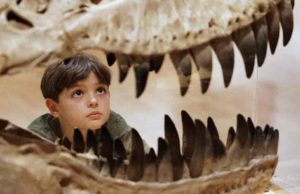
Wings may be the obvious choice when studying the connection between dinosaurs and birds, but a pair of Yale paleontologists prefer drumsticks. That part of the leg, they say, is where fibular reduction among some dinosaurs tens of millions of years ago helped make it possible for peacocks to strut, penguins to waddle, and turkeys to trot.
“A good way to understand this is to take a look at drumsticks, like the ones people eat on Thanksgiving,” said Armita Manafzadeh, lead author of a new study in Nature. She is a postdoctoral researcher affiliated with the Yale Institute for Biospheric Studies, the Department of Earth & Planetary Science, and the Yale Peabody Museum.
“Under the meat of a drumstick, you’ll find two bones — the tibia, which is long and thick, and the fibula, which is much shorter and thinner,” Manafzadeh explained. “This shortened fibula is what allows birds to twist and turn around when they’re not in flight. And to understand its evolutionary story, we have to look at dinosaurs.”
Yet the fibula had been largely overlooked by paleontologists and other scientists, often viewed as merely a small remnant of a once-larger physiological feature. The idea that the shortened fibula had a distinct evolutionary benefit was relatively unexplored.
“The fibula is, in general, the more diminutive of the two lower leg bones, and often neglected in the study of vertebrate form and function,” said Bhart-Anjan Bhullar, associate professor of Earth and planetary sciences in Yale’s Faculty of Arts and Sciences, associate curator at the Yale Peabody Museum, and co-author of the study. “But evolution acts on all parts of the body, great and small. Structures and regions that have been ignored are often gold mines for new insights and untold tales.”
For the study, the researchers used X-ray videos of a present-day bird — a helmeted guineafowl — to precisely measure the knee-joint poses of the bird. Using cutting-edge computer animation software, they combined the videos with 3D models to visualize how the bird’s bone surfaces fit together geometrically and how those joints appeared in motion.
They also collected X-ray videos from an iguana and an alligator and examined the shapes of leg bones in other birds, including a penguin, an ostrich, an owl, and a crane.
The researchers found that in birds, the tibial joint surfaces have curved arcs, and the shortened fibula is able to roll within the bird’s drumstick for about its length relative to the tibia. Taken together, these features enable the knee bones to maintain smooth contact, even when the joint twists by more than 100 degrees.
“You can see that the fibula of birds is moving completely differently from that of other living reptiles,” Manafzadeh said. “It’s why their knees are uniquely able to spin, allowing them to navigate their world more effectively. They use that mobility to turn and maneuver on the ground, but we suspect they’re also using it in mating displays, prey gathering, and moving about tree branches.”
Next, the researchers searched for the evolutionary origins of the shortened fibula in birds — and found their answer in certain species of dinosaurs.
While many dinosaurs, including Tyrannosaurus rex, had straightened tibial surfaces and stiffened drumsticks that only allowed for hinge-like knees, certain avian ancestors, including Rahonavis ostromi and Ichthyornis dispar, showed indications of curved tibial surfaces and a shortened, thinner fibula that was free to move on its own.
“We found that the very features that appeared in early dinosaurs to stiffen the leg ended up being co-opted in birds and their close relatives to mobilize the knee joint in a unique and extreme way,” Bhullar said. “Over and again, we see that evolution operates by repurposing existing structures and functions, often in surprising and unpredictable ways.”
The researchers said several well-known Yale Peabody Museum fossils were pivotal in the work, including Allosaurus, the giant Jurassic predator discovered by O.C. Marsh (which had a stiffened dinosaurian knee); Deinonychus, the “velociraptor” of the “Jurassic Park” films (which had an early form of the birdlike knee joint); and Ichthyornis, whose proto-beak was the subject of an earlier study by Bhullar (and which had a fully modern, avian knee).
The new study is part of Bhullar and Manafzadeh’s ongoing research into the evolution of animal motion, based on their novel method for visualizing how ancient animals moved by comparing their joints with those of modern animals.
Reference:
Armita R. Manafzadeh, Stephen M. Gatesy, John A. Nyakatura, Bhart-Anjan S. Bhullar. Fibular reduction and the evolution of theropod locomotion. Nature, 2024; DOI: 10.1038/s41586-024-08251-w
Note: The above post is reprinted from materials provided by Yale University. Original written by Jim Shelton.










